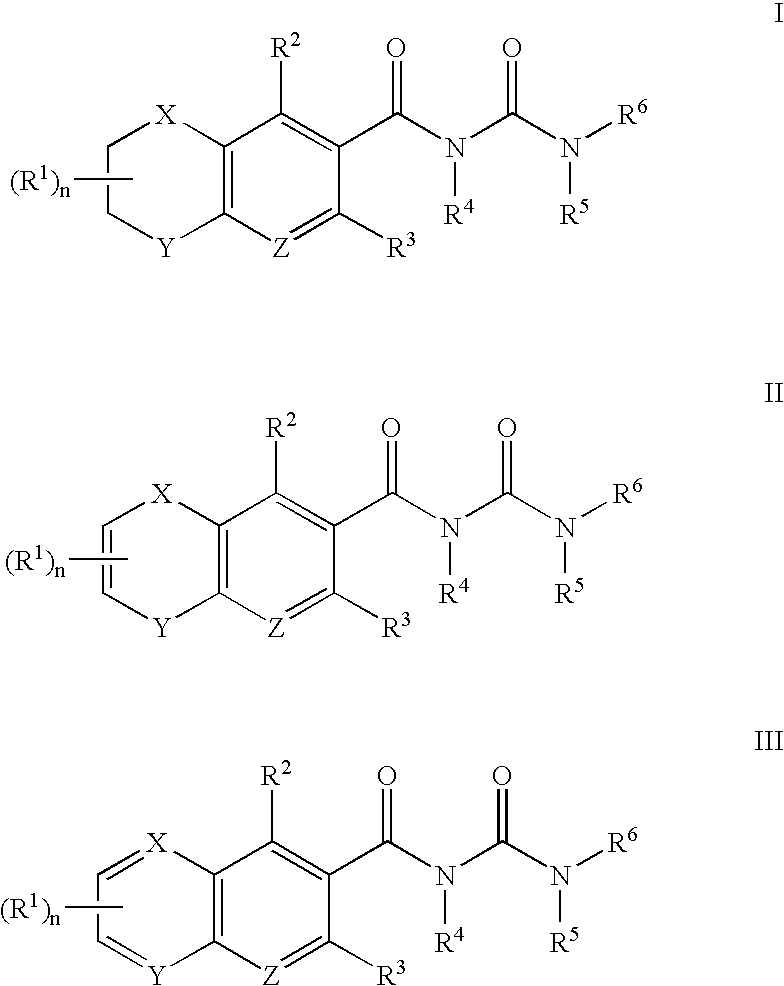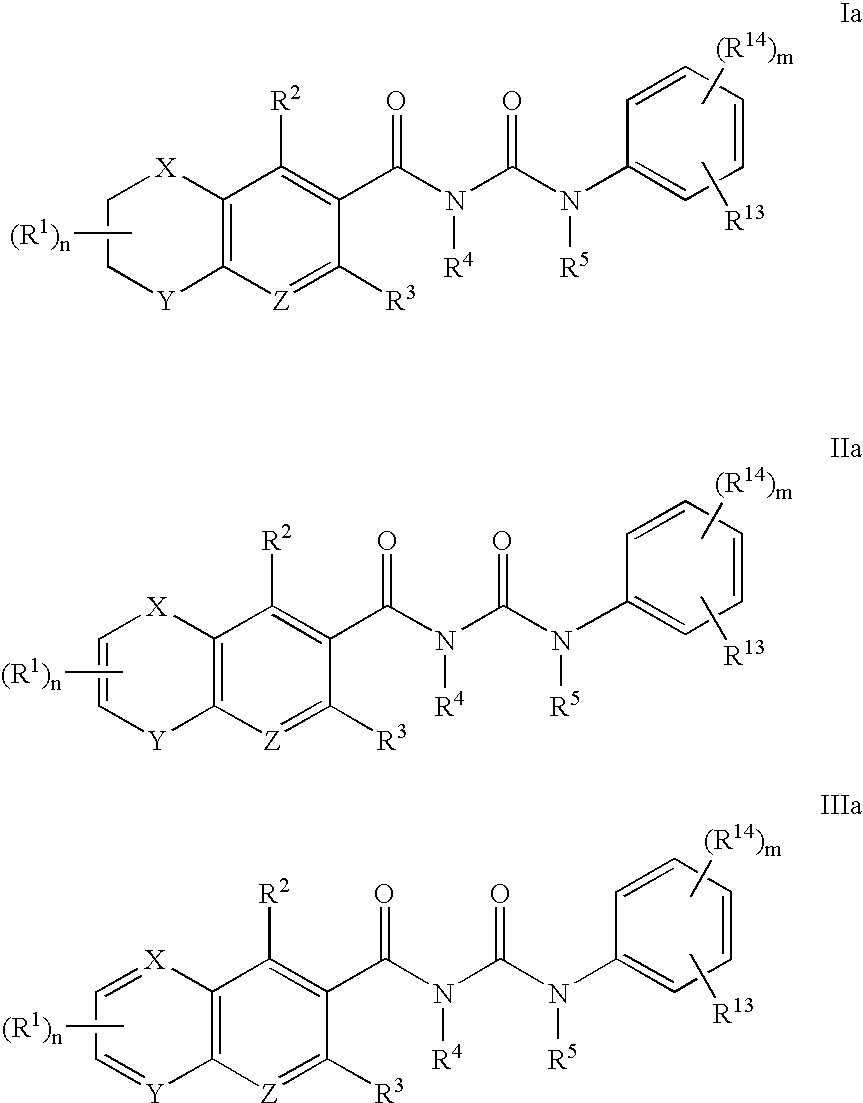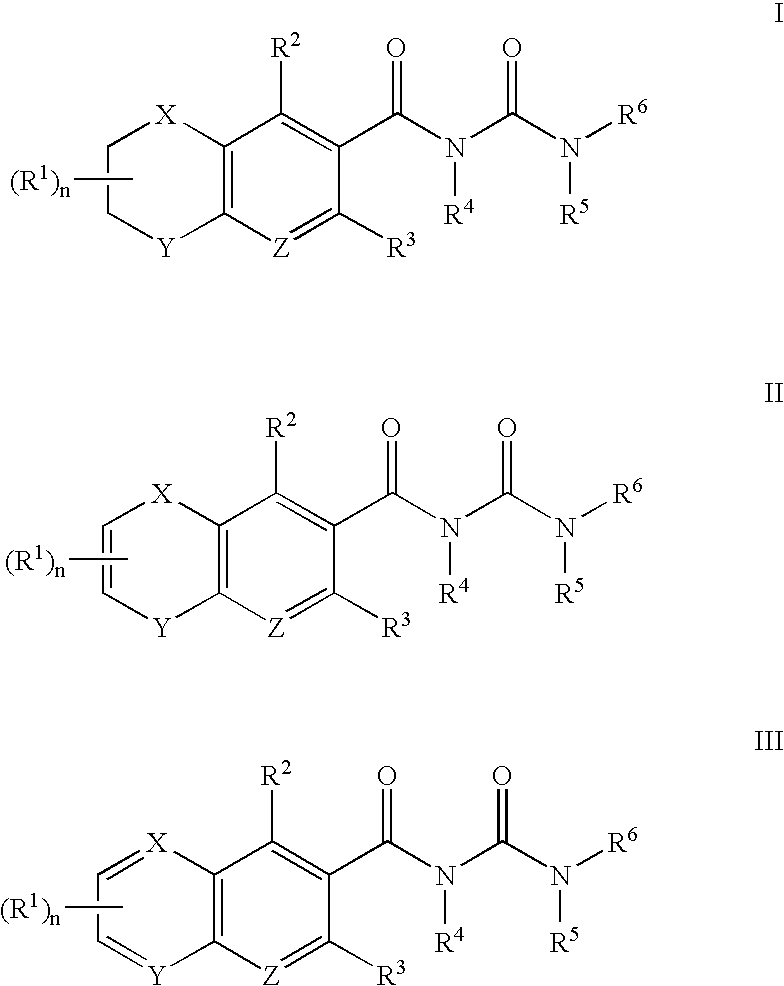Antagonists of MCP-1 function and methods of use thereof
a technology of mcp-1 and anti-mcp-1, applied in the field of compounds, can solve the problems of inflammatory disorders characterized by multiple or redundant chemokine expression profiles, high degree of redundancy in ligands, and relatively more refractory to treatmen
- Summary
- Abstract
- Description
- Claims
- Application Information
AI Technical Summary
Benefits of technology
Problems solved by technology
Method used
Image
Examples
example 1
2H,3H-Benzo[3,4-e]1,4-dioxin-6-yl-N-{[(3-iodophenyl)amino]carbonyl}carboxamide (10)
[0224]
[0225]A solution of potassium permanganate (3.31 g) in water (100 mL) was added over 30 min to a stirred solution of 1,4-benzodioxan-6-carboxaldehyde (2.50 g) in water (40 mL) at 90° C. Stirring was continued at 90° C. for an additional 45 min and the mixture was then cooled to ambient temperature. The mixture was made basic (pH 10) with aqueous 1M KOH solution, filtered, and the filtrate was cooled in an ice-bath and acidified to pH 3 with concentrated HCl. The precipitated solid was collected by filtration, washed with water, and dried. The solid was dissolved in dichloromethane, washed with saturated sodium chloride solution, and dried over magnesium sulfate. The solvent was evaporated under reduced pressure to furnish 2H,3H-benzo[e]1,4-dioxane-6-carboxylic acid as a white powder. A portion of this material (1.05 g) was dissolved in thionyl chloride (10 mL) and the mixture heated at 50° C. un...
example 2
N-{[(3-phenylphenyl)amino]carbonyl}quinoxalin-6-ylcarboxamide (78)
[0226]
[0227]A suspension of methyl quinoxaline-6-carboxylate (2.00 g) in methanol (7.0 mL) and 28-30% ammonia (14 mL) was stirred in a sealed tube at room temperature for 16 h. The precipitated solid was filtered, washed with water and dried under high vacuum to give quinoxaline-6-carboxamide as a white powder. A portion of this material (0.10 g) was suspended in anhydrous dichloromethane and treated with oxalyl chloride (1.0 mL of a 2M solution in dichloromethane) under a nitrogen atmosphere. The mixture was heated at reflux for 16 h and concentrated under reduced pressure. The residue was dissolved in anhydrous tetrahydrofuran (1 mL) and added to an ice-cooled solution of 3-aminobiphenyl (0.98 g) in anhydrous tetrahydrofuran (1 mL). The mixture was stirred at room temperature for 2 h. The solvent was evaporated and the residue taken up in methanol and filtered to give N-{[(3-phenylphenyl)-amino]carbonyl}quinoxalin-6...
example 3
N-{[(3-chlorophenyl)amino]carbonyl}-1,2,3,4-tetrahydroquinoxalin-6-ylcarboxamide (115)
[0228]
[0229]Quinoxaline-6-carboxamide (0.10 g) was dissolved in hot toluene (30 mL) and azeotroped for 1 h. The solution was cooled to room temperature and treated with 3-chlorophenyl isocyanate (0.133 g). The mixture was heated at reflux for 16 h and then cooled to room temperature. The precipitated solid was filtered, washed with methanol, and dried under high vacuum to give N-{[(3-chlorophenyl)amino]-carbonyl}quinoxalin-6-ylcarboxamide as a white solid. A portion of this material (40 mg) was suspended in acetic acid (1.5 mL) in an ice-water bath, and the suspension treated with sodium borohydride (9 mg). After TLC showed complete consumption of the starting material, the solution was poured into water (20 mL). The precipitated solid was filtered, washed with water, and dried under high vacuum to give N-{[(3-chlorophenyl)amino]carbonyl}-1,2,3,4-tetrahydroquinoxalin-6-ylcarboxamide as a yellow sol...
PUM
| Property | Measurement | Unit |
|---|---|---|
| temperature | aaaaa | aaaaa |
| temperature | aaaaa | aaaaa |
| temperature | aaaaa | aaaaa |
Abstract
Description
Claims
Application Information
 Login to View More
Login to View More - R&D
- Intellectual Property
- Life Sciences
- Materials
- Tech Scout
- Unparalleled Data Quality
- Higher Quality Content
- 60% Fewer Hallucinations
Browse by: Latest US Patents, China's latest patents, Technical Efficacy Thesaurus, Application Domain, Technology Topic, Popular Technical Reports.
© 2025 PatSnap. All rights reserved.Legal|Privacy policy|Modern Slavery Act Transparency Statement|Sitemap|About US| Contact US: help@patsnap.com



